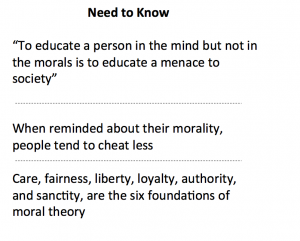Positioning Between the Poles: Is right really right and wrong really wrong?
November 24, 2015 ~ Written by: W.B. “Bud” Kirchner
 “It is helpful to think of people as having two fundamental motivations: the desire to see ourselves as honest, good people, and the desire to gain the benefits that come from cheating – on our taxes or on the football field.” ~ Dan Ariely
“It is helpful to think of people as having two fundamental motivations: the desire to see ourselves as honest, good people, and the desire to gain the benefits that come from cheating – on our taxes or on the football field.” ~ Dan Ariely
Given the holistic nature of the Business Brain Model and given this is a good way to illustrate where new ideas come from (Spoiler Alert: watch for articles on innovation), I want you to consider two polar positions and I encourage you to focus on the area in the middle. Simply put – here are two poles: which pulls you harder?
First, let me direct you to pole #1, which is based on a new book:
Straight To Hell
“To educate a person in the mind but not in morals is to educate a menace to society.” ~ Theodore Roosevelt
“Straight to Hell: True Tales of Deviance, Debauchery and Billion-Dollar Deals” by John LeFevre
By its own description “Straight to Hell” delves deep inside an industry that is both envied and reviled and brazenly pulls back the curtain on the deviant and absolutely excessive world of finance.
There are a couple reasons why I could easily have decided not to mention this book. First and foremost, I have many friends and colleagues involved in the finance industry that do not fit this profile. Also – It appears to me it was written to create a sensational (biased?) picture.
However, many sources think it is a reasonable picture of what goes on. For example:
“There’s no question that [LeFevre] knows his way around the business, and it’s a dirty one. There’s collusion, competition, nepotism, and a whole lot of reprehensible stuff going on in the business side, and it’s fascinating. . . . A great read.”—Business Insider
“In some memoirs, the author tries to pull back the curtain to provide a glimpse into a particular time and place, but LeFevre attempts to rip the drapes right off. He gives a naked look at how business in the world of finance is conducted. LeFevre . . . doesn’t shy away from witnessing and partaking in some of the seedier antics . . . You may not like LeFevre’s tact, but he knows what he’s talking about.”—CNBC
Here are some illustrative one liner’s that reflect (in the writers mind at least) the code of (e.g.) Wall Street: (Just to be clear the words are LeFevre’s, the format is mine.)
LeFevre: On Being Fairness
- “The fact that most people are too stupid to know how dumb they really are is the fabric holding our society together.”
- “There was a time when we sent the undesirables to islands. Now you have to buy an island just to get away from them.”
- “Rules are for the obedience of fools and the guidance of wise men.”*
- “If you’re dumb enough to get caught cheating you don’t belong on Wall Street.”
- “If someone asks you a question and you don’t know the answer, belittle them. It’s better to be an asshole than look stupid.”
- “The only thing more impressive than my accomplishments is my resume.”
LeFevre: On Having Money
- “Money can’t buy happiness but it solves 95% of the problems that make you unhappy.”
- “Insider trading is like pissing in the pool. It sounds dirty, but really isn’t that big of a deal.”
- “Money might not buy happiness, but I’ll take my chances.”
- “What I lack in social skills, I make up in wallet.”
- “Banking has given me a very distorted view of money, priorities and what I deserve or feel that I am entitled to.”
- “Irrespective of what’s in the client’s best interests, there’s no point in bringing a really lucrative deal to market once bonus numbers have been set.”
Straight Outta Hell
In sharp contrast, I direct your attention to the “moral foundations theory” (much of what I will share with you can be found on MoralFoundations.org which is run by social psychologists), which is a combined social and psychological theory that describes the origins and variation in human moral reasoning. Psychologists Jonathan Haidt and Craig Joseph proposed the theory adding on to original work by cultural anthropologist Richard Shweder. The theory was popularized in Haidt’s book titled “The Righteous Mind.”
As with the LeFevre book there were pros and cons of “The Righteous Mind.”. In the latter category, this is one of these quicksand issues that fuels endless debates involving psychologists and philosophers. On the other hand I wanted a context for readers to consider point/counterpoint.
Alternative Destination
“Waste no more time arguing about what a good man should be. Be one.” ~ Marcus Aurelius
The following are the so called six foundations of moral theory including values and their opposites:
- Care/harm:
- Einfuhlung (empathy) for others.
- Fairness/cheating:
- Equal justice.
- Liberty/oppression:
- Opposing tyranny.
- Loyalty/betrayal:
- “One for all, and all for one.” ~ Alexandre Dumas
- Authority/subversion:
- Respect for tradition.
- Sanctity/degradation:
- Striving for nobility.
So – as promised I have presented two diametrically opposed views of the world. I encourage you to reflect on your career and life and consciously allow yourself to be attracted by one pole and repulsed by the other.
Which Pole Are You Attracted To?
“Right is right even if no one is doing it; wrong is wrong even if everyone is doing it.” – Augustine of Hippo
One person who has given a lot of thought to this question of morality and how we position ourselves between the ‘poles’ I have just described, is Dan Ariely who sees this as a manifestation of (predictable) irrationality.
I direct you to “Our buggy moral code” – Dan Ariely – TED Talk.
One of the fascinating aspects of Ariely’s work to me is the fact that right and wrong has no clear demarcation in action. It seems to be an ‘operational definition.’
The salient points of his research around the moral code – are illustrated by cheating. Here I quote his summary:
- We’ve learned that a lot of people can cheat. They cheat just by a little bit.
- When we remind people about their morality, they cheat less.
- When we get bigger distance from cheating, from the object of money, for example, people cheat more.
- And when we see cheating around us, particularly if it’s a part of our in-group, cheating goes up.
Ariely illustrates the inherent problem via the stock market – what better metaphor?
“What happens when you do other things, like you remove things from money? You call them stock, or stock options, derivatives, mortgage-backed securities. Could it be that with those more distant things, it’s not a token for one second, it’s something that is many steps removed from money for a much longer time — could it be that people will cheat even more? And what happens to the social environment when people see other people behave around them? I think all of those forces worked in a very bad way in the stock market.”
In closing, I can only point out the obvious – while (hopefully) business people choose to avoid the LeFevre pole they (depending on circumstances) don’t always make it to the Haidt pole. Somehow neuroscience and psychology dictates they sometimes fall short.
So which pole attracts you most? And why? I’d love to hear what pulls at your brain and your heart and if that pull is the same.
*LeFevre’s “number one rule of life” is originally credited to Douglas Bader, English WWII Pilot.
About the Author: W.B. “Bud” Kirchner is a serial entrepreneur and philanthropist with more than 50 years of business success. He is not a scientist or an academic but he does have a diversified exposure to neuroscience, psychology and related cognitive sciences. Generally speaking, the ideas he expresses here are business-angled expansions of other people’s ideas, so when possible, he will link to the original reference.
